


For something a little special, you can select one of these
premium woods for your custom built guitar or bass. There is some rarity in these woods in that
to find superlative examples we must sort through large amounts of wood. Like you, we only want the
good stuff!
 Of course it's not all about
beauty, each of these woods contributes something different to the sound. Some are more obvious than others, almost
everyone can hear the warmth of Koa or the complex bright and dark tone of Coco Bolo. The more you get a chance to
hear, the better you will get at hearing. Of course it's not all about
beauty, each of these woods contributes something different to the sound. Some are more obvious than others, almost
everyone can hear the warmth of Koa or the complex bright and dark tone of Coco Bolo. The more you get a chance to
hear, the better you will get at hearing.
 Neck through construction will isolate the influence of the top wood more than a set neck does. The observations
noted are for Alembic instruments, other makers may have differing results depending on technique and the
electronics systems used.
Neck through construction will isolate the influence of the top wood more than a set neck does. The observations
noted are for Alembic instruments, other makers may have differing results depending on technique and the
electronics systems used.

|
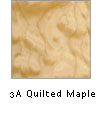 3A Quilted Maple pictured on a Signature Standard bass. Quilted Maple gives a lovely brightness,
with a distinctive "shimmer" to the decaying sound. The figuring covers at least 75% of the face.
3A Quilted Maple pictured on a Signature Standard bass. Quilted Maple gives a lovely brightness,
with a distinctive "shimmer" to the decaying sound. The figuring covers at least 75% of the face.

|
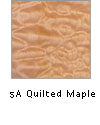 5A Quilted Maple pictured on a custom Series II 7-string bass. It has the same tonal characteristics
as 3A Quilt, but the figuring is much more intense and covers at least 95% of the face. Each "quilt" is deeply incised and looks
3-dimensional, with sizes ranging from small coins to large capsules that span the entire width of the body.
5A Quilted Maple pictured on a custom Series II 7-string bass. It has the same tonal characteristics
as 3A Quilt, but the figuring is much more intense and covers at least 95% of the face. Each "quilt" is deeply incised and looks
3-dimensional, with sizes ranging from small coins to large capsules that span the entire width of the body.

|
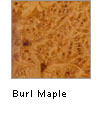 Burl Maple pictured on an Excel bass. Usually a darker color than other maples, Burl Maple sometimes
includes some spalting (dark lines caused by a fungus). When we finish Burl Maple, or any burl wood, the voids are filled with the actual polyester
finish, and not a wood filler. It takes longer, it's harder, and it costs more to do it that way, but it's worth it.
Burl Maple pictured on an Excel bass. Usually a darker color than other maples, Burl Maple sometimes
includes some spalting (dark lines caused by a fungus). When we finish Burl Maple, or any burl wood, the voids are filled with the actual polyester
finish, and not a wood filler. It takes longer, it's harder, and it costs more to do it that way, but it's worth it.

|
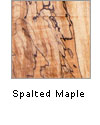 Spalted Maple pictured on a Series II guitar. We strive to find examples of this wood that
have flame figuring before they are spalted. Any spalted wood will be less dense than in non-spalted form, so extreme highs will not
be as apparent.
Spalted Maple pictured on a Series II guitar. We strive to find examples of this wood that
have flame figuring before they are spalted. Any spalted wood will be less dense than in non-spalted form, so extreme highs will not
be as apparent.

|
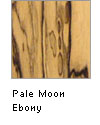 Pale Moon Ebony pictured on a Rogue bass. This wood rarely comes along in widths
adequate to make a bookmatched top, and we've got just enough for for more instruments. Just as dense as the darker varieties that are more familiar, Pale Moon Ebony
produces a focused tone with excellent support for both highs and lows.
Pale Moon Ebony pictured on a Rogue bass. This wood rarely comes along in widths
adequate to make a bookmatched top, and we've got just enough for for more instruments. Just as dense as the darker varieties that are more familiar, Pale Moon Ebony
produces a focused tone with excellent support for both highs and lows.
|
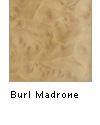 Madrone Burl pictured on a fretless Rogue bass. Dense enough to bouce the highs
back to the string, but not overpoweringly bright. Madrone Burl looks similar to Burl Maple, but is less yellow
and typically has a consistent density of figure.
Madrone Burl pictured on a fretless Rogue bass. Dense enough to bouce the highs
back to the string, but not overpoweringly bright. Madrone Burl looks similar to Burl Maple, but is less yellow
and typically has a consistent density of figure.
|
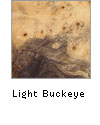 Light Buckeye Burl pictured on a custom Signature Standard bass. The light yellow
is the native color of the wood, with the darker stain produced by a fungus. Once it dries, the fungus is
arrested and it won't decay any more. Light Buckeye will have between 60-90% light colored wood.
Light Buckeye Burl pictured on a custom Signature Standard bass. The light yellow
is the native color of the wood, with the darker stain produced by a fungus. Once it dries, the fungus is
arrested and it won't decay any more. Light Buckeye will have between 60-90% light colored wood.
|
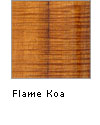 Flame Koa pictured on a Series II bass. Koa has a mellow tone, with big, plump
low end response. Better for fingerstyle playing as a slapper will have to fight its mellow nature (but
we certainly have heard players who can overcome the default tone of Koa).
Flame Koa pictured on a Series II bass. Koa has a mellow tone, with big, plump
low end response. Better for fingerstyle playing as a slapper will have to fight its mellow nature (but
we certainly have heard players who can overcome the default tone of Koa).
|
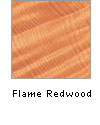 Flame Redwood pictured on an Orion bass. Another big beefy tone wood, Redwood
produces a deep rich tone. The color is like a warm rosy wash over Flame Maple. It's absolutely gorgeous.
Flame Redwood pictured on an Orion bass. Another big beefy tone wood, Redwood
produces a deep rich tone. The color is like a warm rosy wash over Flame Maple. It's absolutely gorgeous.
|
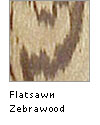 Flatsawn Zebrawood pictured on a Rogue bass. This is the same species as the
standard Zebrawood (which is quartersawn), but flatsawing slices through the growth rings to spread them out
in an erratic pattern.
Flatsawn Zebrawood pictured on a Rogue bass. This is the same species as the
standard Zebrawood (which is quartersawn), but flatsawing slices through the growth rings to spread them out
in an erratic pattern.
|
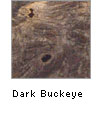 Dark Buckeye Burl pictured on a Signature Deluxe bass. Dark Buckeye
looks less like wood and more like stone. We specify that 60-90% of the wood is the dark fungal stain, in colors
that mix aspects of blue, green, and gray. Light or Dark Buckeye may include inlays of wood where large voids
or bark inclusions were. Small bark inclusions are often left in place.
Dark Buckeye Burl pictured on a Signature Deluxe bass. Dark Buckeye
looks less like wood and more like stone. We specify that 60-90% of the wood is the dark fungal stain, in colors
that mix aspects of blue, green, and gray. Light or Dark Buckeye may include inlays of wood where large voids
or bark inclusions were. Small bark inclusions are often left in place.
|
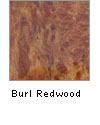 Burl Redwood pictured on an Essence bass. A nice ruddy color, which sometimes has a
tinge of purple with scatterd patches of highly scuptured burl figure. Tonally, Burl Redwood packs deep, dare we
say "burly" bass reponse.
Burl Redwood pictured on an Essence bass. A nice ruddy color, which sometimes has a
tinge of purple with scatterd patches of highly scuptured burl figure. Tonally, Burl Redwood packs deep, dare we
say "burly" bass reponse.
|
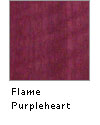 Flame Purpleheart pictured on an Essence bass. Like its standard wood counterpart,
Flame Purpleheart is a lovely natural shade of violet, but with an overlay of flame figuring. The familiar
flutter of flame figure isn't as intense as you find on other woods, but it's still amazing looking.
Flame Purpleheart pictured on an Essence bass. Like its standard wood counterpart,
Flame Purpleheart is a lovely natural shade of violet, but with an overlay of flame figuring. The familiar
flutter of flame figure isn't as intense as you find on other woods, but it's still amazing looking.
|
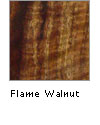 Flame Walnut pictured on a Signature Standard bass. When Nature decides to
infuse Walnut with flame figuring, the result is stunning. Flame Walnut imparts the familiar fast attack
and excellent high end response as our standard Walnut. Typically Flame Walnut lightens over time.
Flame Walnut pictured on a Signature Standard bass. When Nature decides to
infuse Walnut with flame figuring, the result is stunning. Flame Walnut imparts the familiar fast attack
and excellent high end response as our standard Walnut. Typically Flame Walnut lightens over time.
|
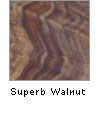 Supreme Walnut pictured on a custom Signature Deluxe bass. We have our own
classification for extra-special Walnut. Supreme Walnut is always heavily flame figured, always has color
zoning, and always has something interesting to offer the eyes.
Supreme Walnut pictured on a custom Signature Deluxe bass. We have our own
classification for extra-special Walnut. Supreme Walnut is always heavily flame figured, always has color
zoning, and always has something interesting to offer the eyes.
|
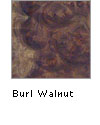 Burl Walnut pictured on a Signature Standard 5-string bass. Always different, always beautiful, our
Burl Walnut is a rich dark color sometimes with lighter areas. Burls can range in size from small to large, even on the same piece,
but we always select wood with dense figuring.
Burl Walnut pictured on a Signature Standard 5-string bass. Always different, always beautiful, our
Burl Walnut is a rich dark color sometimes with lighter areas. Burls can range in size from small to large, even on the same piece,
but we always select wood with dense figuring.
|
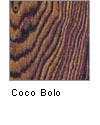 Coco Bolo pictured on a Signature Deluxe bass. If you have spent any time on our
website, you already know that Coco Bolo is practially our house wood. What is not to love? The main color is
an orage-red with dark coffee graining. As a Rosewood, the tone is complex - bright from the density and dark
from the oils in the wood. If you just can't decide, you simply can't go wrong with Coco Bolo.
Coco Bolo pictured on a Signature Deluxe bass. If you have spent any time on our
website, you already know that Coco Bolo is practially our house wood. What is not to love? The main color is
an orage-red with dark coffee graining. As a Rosewood, the tone is complex - bright from the density and dark
from the oils in the wood. If you just can't decide, you simply can't go wrong with Coco Bolo.
|
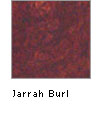 Jarrah Burl pictured on a fretless Rogue bass. A deep reddish color with near black
swirls throughout the burl, Jarrah Burl is typically wall-to-wall figure.
Jarrah Burl pictured on a fretless Rogue bass. A deep reddish color with near black
swirls throughout the burl, Jarrah Burl is typically wall-to-wall figure.
|
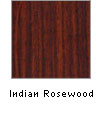 Indian Rosewood pictured on a Europa bass. Sporting a nice brown color with violet leanings,
Indian Rosewood has a rich look to match its rich tone. As with other Rosewoods, the complex tone is both bright and dark. Most
of the lumber we have is quartersawn like the example.
Indian Rosewood pictured on a Europa bass. Sporting a nice brown color with violet leanings,
Indian Rosewood has a rich look to match its rich tone. As with other Rosewoods, the complex tone is both bright and dark. Most
of the lumber we have is quartersawn like the example.
|
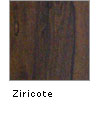 Ziricote pictured on a Rogue bass. Looking a bit like Ebony, only in coffee shades rather than black,
Ziricote can be straight grained or sometimes look like picture jasper, with overlapping layers.
Ziricote pictured on a Rogue bass. Looking a bit like Ebony, only in coffee shades rather than black,
Ziricote can be straight grained or sometimes look like picture jasper, with overlapping layers.
|
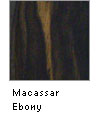 Macassar Ebony pictured on an Excel bass. The darkest wood we can get (except when a piece of wide
Gabon Ebony finds its way here (which is rare)), but the tone is snappy, distinct and full of healthy low end. Generally a near-black color with
streaks of varying shades of chocolate or sometimes grayish brown.
Macassar Ebony pictured on an Excel bass. The darkest wood we can get (except when a piece of wide
Gabon Ebony finds its way here (which is rare)), but the tone is snappy, distinct and full of healthy low end. Generally a near-black color with
streaks of varying shades of chocolate or sometimes grayish brown.
© 2010 Alembic, Inc.

|
